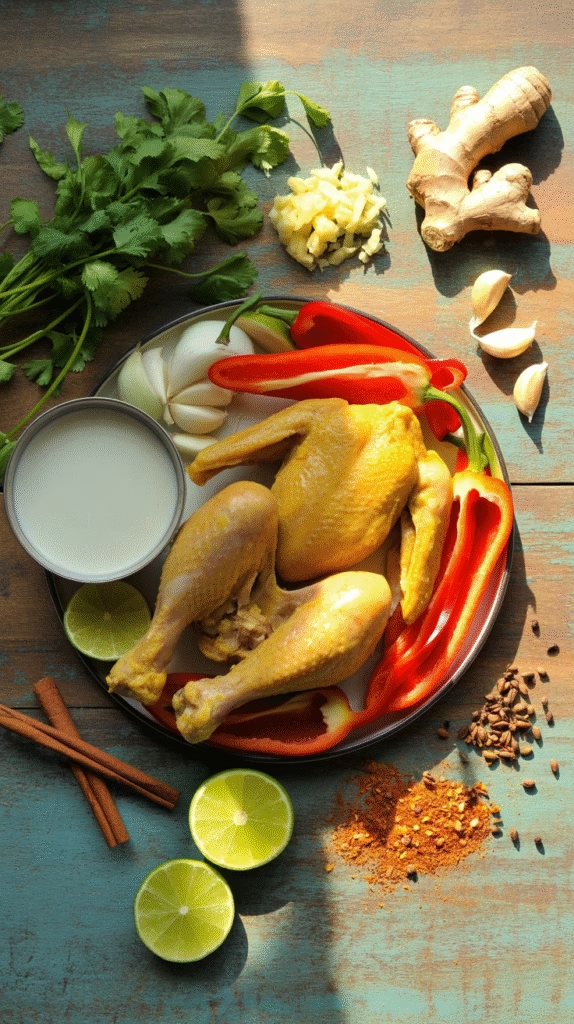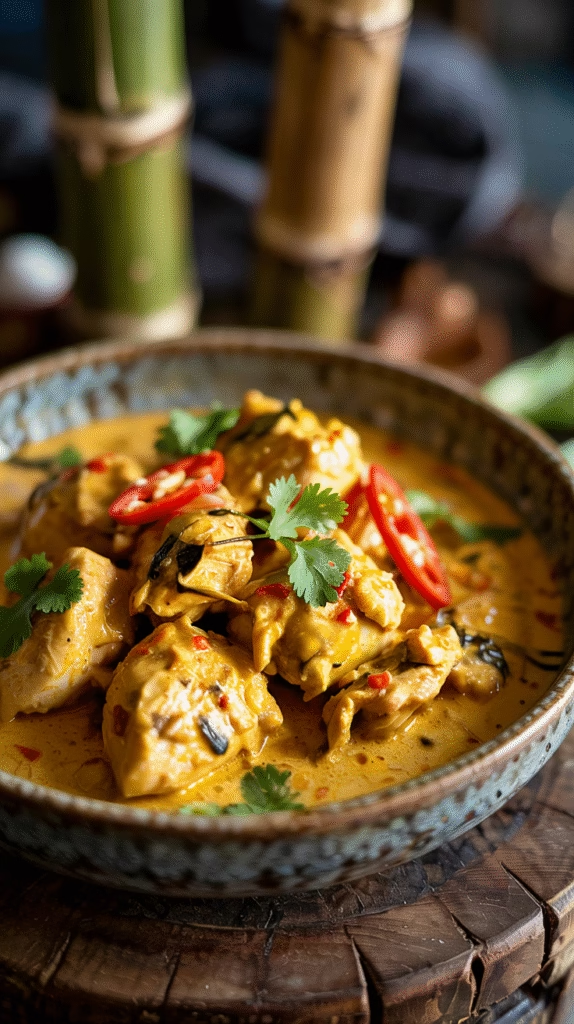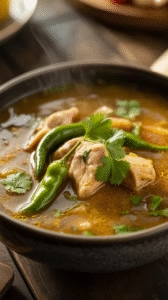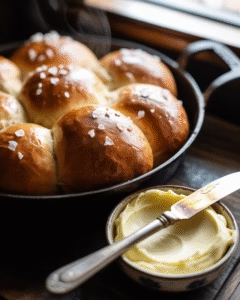There are countless reasons why coconut curry chicken should become a staple in your recipe collection:
- Creamy, flavorful, and aromatic—perfect for weeknights or special occasions
- Easy to customize to suit your preferences (spicy, mild, veggie-packed, or with protein swaps)
- Meal-prep friendly—not only does it store well, but it actually tastes even better the next day as the flavors deepen
- Gluten-free & dairy-free by nature, making it ideal for those with dietary restrictions
This versatile dish bridges multiple culinary traditions, drawing inspiration from Thai, Indian, and Caribbean cuisines. No matter which direction you take it, you’ll end up with a bowl of comfort that satisfies both the palate and the soul.

Essential Ingredients for the Best Coconut Curry Chicken
Chicken: Thighs vs. Breasts
While both options work well, chicken thighs are the preferred choice for many curry connoisseurs. They remain tender and juicy even after extended cooking, and their higher fat content contributes richness to the final dish. If you prefer chicken breasts, take care not to overcook them—they’re best added slightly later in the cooking process to prevent drying out.
Coconut Milk: Full-Fat vs. Light
For an authentic, restaurant-quality curry, full-fat coconut milk is non-negotiable. It provides the silky, luxurious texture that makes coconut curry so irresistible. Light coconut milk will work in a pinch, but the result will be thinner and less satisfying. For an extra indulgent experience, replace a portion of the coconut milk with coconut cream.
Curry Paste: Red, Yellow, or Green?
Each curry paste offers a distinct flavor profile:
- Red curry paste: Medium heat with a balance of sweet, savory, and spicy notes
- Yellow curry paste: Milder with turmeric as the star, offering earthy, warm flavors
- Green curry paste: Often the spiciest, with bright, herbaceous flavors from fresh green chilies and herbs
Choose based on your heat preference and the flavor profile you’re craving. Homemade curry paste is phenomenal if you have the time, but quality store-bought options provide excellent results for weeknight cooking.
Aromatics: The Flavor Foundation
The holy trinity of curry aromatics—garlic, ginger, and onions—creates the crucial flavor base. Take time to sauté these properly until fragrant and softened, as this step builds the foundation for your entire dish. Fresh ingredients make a noticeable difference, but jarred minced garlic and ginger can save time without sacrificing too much flavor.
Spices: The Soul of Curry
Even when using curry paste, additional spices elevate your dish:
- Turmeric: Adds golden color and earthy warmth
- Cumin: Provides nutty, warm depth
- Coriander: Contributes citrusy brightness
- Garam masala: A complex spice blend that adds dimension
- Cardamom: Optional but adds an aromatic, slightly sweet note
Always “bloom” your spices by briefly toasting them in oil before adding liquid ingredients—this simple step releases their essential oils and dramatically enhances flavor.
Fresh Herbs: The Finishing Touch
Fresh herbs brighten the rich curry and add visual appeal:
- Cilantro: The classic garnish, adding freshness and color
- Thai basil: Offers anise notes and stands up well to the heat of cooking
- Mint: A surprising but delightful addition, especially for summer meals

Step-by-Step Cooking Instructions
1. Prep the Chicken for Maximum Flavor
For truly exceptional curry chicken, consider marinating your chicken pieces for 30 minutes to overnight. A simple marinade of yogurt, lemon juice, salt, and a pinch of turmeric tenderizes the meat while infusing flavor. If short on time, simply season chicken pieces with salt and pepper before cooking.
Cut chicken into consistent, bite-sized pieces (about 1-inch cubes) to ensure even cooking. Pat dry with paper towels before cooking to promote better browning.
2. Sauté Aromatics: Building Your Flavor Base
Heat 2 tablespoons of oil in a large, heavy-bottomed pot over medium heat. Add diced onions first, cooking until translucent (about 3-4 minutes), then add minced garlic and ginger. The key is low and slow—high heat will burn these delicate aromatics, creating bitter flavors.
When the mixture becomes fragrant and golden (after about 2 minutes), it’s time to add your curry paste and dry spices. Stir continuously for 30-60 seconds until everything smells toasty and aromatic—this crucial “blooming” step unlocks maximum flavor.
3. Simmer the Curry to Perfection
Add your chicken pieces to the pot, stirring to coat with the aromatic mixture. Allow the chicken to sear slightly for 2-3 minutes before adding coconut milk. Pour in your coconut milk slowly, stirring to incorporate all the flavors from the bottom of the pot.
Bring the mixture to a gentle simmer (never a rolling boil, which can cause coconut milk to separate), then reduce heat to low. Cover partially and let it simmer for 15-20 minutes for chicken thighs, or 10-15 minutes for chicken breasts, until the meat is tender and fully cooked.
For a thicker curry, simmer uncovered for a few extra minutes to reduce the sauce. For a thinner consistency, add a splash of chicken stock or water.
4. Adjust Seasoning: The Final Balancing Act
A perfect curry balances sweet, salty, spicy, and tangy flavors. After the curry has simmered:
- Taste and add salt as needed (start with ½ teaspoon)
- For sweetness, add a teaspoon of brown sugar or palm sugar
- For tanginess, squeeze in fresh lime juice
- For heat, stir in red pepper flakes or sriracha
- For depth, add a splash of fish sauce or soy sauce
Let the curry rest off heat for 5-10 minutes before serving—this allows flavors to meld and develop complexity.
Expert Tips for the Perfect Coconut Curry Chicken
🔥 Spice Control
Curry’s heat level is entirely customizable:
- For mild curry: Use yellow curry paste and remove seeds from any fresh chilies
- For medium heat: Use red curry paste and add a small amount of chili flakes
- For spicy curry: Use green curry paste and add fresh Thai chilies or cayenne powder
Remember that you can always add more heat, but you can’t remove it. Start conservative and adjust upward.
🥥 Coconut Milk Hacks
To prevent coconut milk from separating:
- Avoid boiling—keep at a gentle simmer
- Stir occasionally during cooking
- If separation occurs, a splash of cornstarch slurry (1 teaspoon cornstarch mixed with 1 tablespoon water) can help reunite the sauce
Quality matters—look for coconut milk with minimal additives, ideally just coconut and water. Thai Kitchen, Chaokoh, and Aroy-D are reliable brands.
🍗 Protein Alternatives
While chicken is traditional, coconut curry welcomes many proteins:
- Shrimp: Add in the last 3-4 minutes of cooking to prevent overcooking
- Tofu: Firm or extra-firm, pressed and cubed, ideally pan-fried separately first
- Chickpeas: Drained and rinsed, added alongside the coconut milk
- Mixed seafood: A combination of firm white fish, shrimp, and scallops for a luxurious curry
🌿 Fresh vs. Dried Herbs
Both have their place in curry-making:
- Use dried herbs and spices early in the cooking process to infuse the oil and develop flavor
- Add fresh herbs at the very end of cooking or as garnish to preserve their bright flavor and color
- If substituting dried for fresh, remember the 1:3 ratio—1 teaspoon dried equals 3 teaspoons (1 tablespoon) fresh

Common Mistakes to Avoid
❌ Overcooking the Chicken
Overcooked chicken becomes tough and stringy. For thighs, cook until they reach 175°F (79°C); for breasts, aim for 165°F (74°C). If you’re uncertain, invest in an instant-read thermometer—it’s a game-changer for perfectly cooked proteins.
❌ Using Low-Quality Coconut Milk
The coconut milk makes or breaks your curry. Avoid brands with unnecessary thickeners, stabilizers, or sweeteners. The ingredient list should be simple: coconut, water, and perhaps guar gum (a natural stabilizer). The difference in flavor between premium and budget brands is remarkable.
❌ Skipping the Spice-Blooming Step
Toasting spices in oil wakes up their flavor compounds. Skip this step, and you’ll miss out on significant depth and complexity. Take the extra minute to bloom your spices—you’ll be rewarded with dramatically improved flavor.
Serving Suggestions & Pairings
🍚 Best Rice Options
Rice is the perfect canvas for soaking up curry sauce:
- Jasmine rice: Aromatic and slightly sticky, traditional with Thai curries
- Basmati rice: Fragrant with distinct grains, perfect for Indian-inspired curries
- Coconut rice: Cook regular rice with part coconut milk for an extra layer of flavor
- Cauliflower rice: A lower-carb alternative that still soaks up flavor beautifully
🥖 Side Dishes
Complement your curry with these traditional accompaniments:
- Naan bread: Perfect for scooping up sauce, especially garlic or cheese varieties
- Roti or chapati: Thinner than naan, with a more rustic texture
- Papadums: Crispy lentil wafers that provide textural contrast
- Cucumber raita: A cooling yogurt-based side that balances spicy curries
🥗 Fresh Toppings
Fresh garnishes add texture, visual appeal, and flavor complexity:
- Lime wedges for squeezing over individual portions
- Chopped peanuts or cashews for crunch
- Fresh cilantro or Thai basil leaves
- Thinly sliced red chilies for heat-lovers
- A swirl of coconut cream for visual drama
🍷 Drink Pairings
The right beverage enhances your curry experience:
- Beer: Light lagers or wheat beers complement without overwhelming
- Wine: Off-dry Riesling or Gewürztraminer stands up to spice
- Non-alcoholic: Mango lassi or coconut water provide tropical complements
Storage & Reheating Tips
Coconut curry chicken arguably tastes better the next day as flavors meld and develop overnight.
✔️ Refrigerator Storage
Store cooled curry in airtight containers for up to 3-4 days. Glass containers are ideal as they won’t absorb curry’s potent aromas or stain from turmeric.
✔️ Freezer Storage
Freeze curry flat in zip-top freezer bags (removing as much air as possible) or in freezer-safe containers, leaving room for expansion. Label with the date and use within 2-3 months for best quality.
✔️ Reheating Methods
- Stovetop: The gold standard—reheat gently over medium-low heat, stirring occasionally
- Microwave: Use 50% power in short intervals, stirring between each
- Add fresh garnishes after reheating to revive the dish’s vibrancy
If the sauce has thickened too much during storage, thin with a splash of coconut milk or chicken broth.
Conclusion
Now that you’ve mastered this coconut curry chicken recipe, it’s time to enjoy a restaurant-quality meal at home! Whether you’re cooking for family or meal-prepping for the week, this dish is versatile, flavorful, and foolproof.
The beauty of curry lies in its adaptability—once you understand the basic technique, you can customize endlessly to suit your preferences and ingredients on hand. Each batch becomes a personal expression of your taste.
Coconut Curry Chicken: A Creamy, Flavorful Delight
Course: Main DishCuisine: Thai, IndianDifficulty: Easy4-6p
servings15
minutes25
minutes420
kcal40
minutesThis creamy and aromatic Coconut Curry Chicken is a perfect weeknight dinner that brings restaurant-quality flavors to your home kitchen. Tender pieces of chicken are simmered in a rich coconut milk sauce infused with fragrant curry paste, fresh ginger, and garlic. The addition of colorful vegetables like bell peppers and green beans makes this a complete, satisfying meal. With its perfect balance of creamy, spicy, and slightly sweet flavors, this curry is comfort food at its finest. Best served over steamed rice, it’s a crowd-pleasing dish that comes together in just 40 minutes.
Ingredients
For the Chicken:
2 lbs (900g) boneless, skinless chicken thighs or breasts, cut into 1-inch pieces
1 teaspoon salt
1/2 teaspoon black pepper
2 tablespoons vegetable oil or coconut oil
- For the Curry:
1 medium onion, finely chopped (about 1 cup)
3 cloves garlic, minced
1 tablespoon fresh ginger, minced
2-3 tablespoons red curry paste (adjust to taste)
1 can (14 oz/400ml) coconut milk, full-fat
1/2 cup chicken broth
2 tablespoons fish sauce
1 tablespoon brown sugar
1 tablespoon lime juice
1 red bell pepper, sliced
1 cup green beans, trimmed and cut into 2-inch pieces
2 tablespoons fresh cilantro, chopped
1 Thai chili or jalapeño, sliced (optional, for heat)
Directions
- Prepare the Chicken: Season chicken pieces with salt and pepper. Heat oil in a large skillet or wok over medium-high heat. Add chicken and cook for 5-7 minutes until browned on all sides. Remove chicken and set aside.
- Build the Base: In the same pan, add chopped onion and cook for 3-4 minutes until softened. Add minced garlic and ginger, cook for another 30 seconds until fragrant.
- Add Curry Paste: Stir in the red curry paste and cook for 1 minute, stirring constantly to prevent burning.
- Create the Sauce: Pour in coconut milk, chicken broth, fish sauce, and brown sugar. Stir well to combine and bring to a gentle simmer.
- Add Vegetables: Add the red bell pepper and green beans to the sauce. Simmer for 5 minutes until vegetables start to soften.
- Return Chicken: Add the browned chicken back to the pan. Simmer for 8-10 minutes until chicken is cooked through (internal temperature of 165°F/74°C) and sauce has thickened slightly.
- Finish and Serve: Remove from heat, stir in lime juice and fresh cilantro. Taste and adjust seasoning with more fish sauce, lime juice, or sugar as needed.
Notes
- Spice Level: Adjust curry paste amount based on your heat preference. Start with 2 tablespoons for mild, use 3+ for spicier.
Coconut Milk: Use full-fat coconut milk for the creamiest texture. Shake the can before opening.
Chicken Choice: Thighs stay more tender, but breasts work too. Don’t overcook to prevent dryness.
Vegetable Variations: Try snap peas, baby corn, bamboo shoots, or eggplant.



